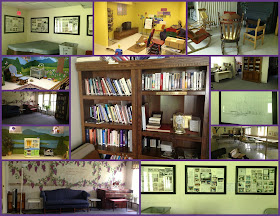One endearing aspect of rural and small town church
communities is the familial atmosphere and the sense one has of being cared for
as a member of the family. At St. Thomas
and Grace (the two parishes of Brandon and Forestdale have combined into one),
that sense of family is more literal than many other churches, for virtually
every one of the roughly 70 members is indeed related to one another. And those
who are not literally related are quickly assimilated into the body and made welcome
as part of the family. So fellowship
time after worship can become something of a glorified family reunion!
 |
| St. Thomas Church, Brandon |
 |
| Grace Church, Forestdale |
Like any family with the inevitable chances for squabbling
and bickering, this family has learned to adjust and compromise. Perhaps the
greatest compromise came when the congregations of St. Thomas in Brandon and
Grace Church in Forestdale found it necessary to merge the congregations.
Imagine telling a pair of sisters that they must now share a room. You can predict the hue and cry over who will
have to move into whose room! In this
family, a compromise was struck out of fiscal necessity. During the warm temperature months, the
congregation worships at St. Thomas. To reduce the cost of heating fuel, they worship
at Grace Church in Forestdale during the winter months. Grace Church, a quaint New England wooden
clapboard building that is much smaller than St. Thomas, is significantly more
conducive to keeping warm. So far, the congregation has managed to be able to
afford the two locations, but there may come a time when they will have to
consider closing one of the buildings. Grace Church is smaller and easier to
maintain and has some property. But St.
Thomas is more conveniently located and has a rectory. Both buildings have equally loyal and devoted
proponents. Still, as yet, this is not an imminent decision, so we won’t borrow
trouble!
 |
| images at St. Thomas... |
St. Thomas Episcopal Church is a stately building that
dominates the hill in Brandon, VT. Like
a number of other churches in the diocese, St. Thomas was designed by Bishop
John Henry Hopkins. It is the only stone church in town and has an equally
impressive rectory next door. In fact,
the rectory is the largest in the diocese. The building was left to St. Thomas
Church by the Conant family with the stipulation that it be rented out to provide
the church with an income stream. Today,
the Vestry is in the early planning stages for converting the building into
apartments that can be leased, including an apartment for the rectory. Currently, the rector shares the house with a
small family who lives in the upstairs portion of the house. Part of the planning will take into
consideration the parish’s dedication to environmental stewardship and finding
ways to make the building “green”.
One step in the effort has already been taken. A pellet stove has been installed in the
rectory to reduce the
 |
| ...and Grace |
reliance on fossil fuels. In the other buildings, new
low-volume bathrooms have been installed to help reduce the amount of water
waste. Energy saving lights have
replaced the old fixtures and are already showing a positive effect on the
electric bill. St. Thomas is also
committed to recycling, reusing and reducing.
They make every effort to ensure that all functions at the church are as
near zero-waste as possible. To that end,
they’ve set up a composting system that includes a biodegradable compost for
paper and most food scraps, and a compost bin specific for breaking down meat
by-waste like fats and bones and other lipids and proteins. What cannot be
composted—glass, plastics, metals—is recycled if it can’t be used again.
The results of all this compost is great topsoil that is
used in their community gardens. The garden beds are on the rectory lawn and
produce food enough for members of the congregation and community alike. They are small gardens and require gardening
from a number of members. But the
results are that each week produce is shared with the congregation and
leftovers are given to the local food shelf.
By the end of summer, over ninety bags of groceries will have been
donated from the gardens.
St. Thomas and Grace have adapted and are very accepting of
change. There are only about seventy
members, yet they have a Sunday school of up to twenty children. School-aged children’s schedules being what
they are, there is the perennial problem of having acolytes. Rather than scheduling acolytes, they allow
anyone who is there on a given Sunday to be an acolyte. So the church has plenty of torches to bear
and they made fun red t-shirts with “acolyte” emblazoned across the front that
the kids can wear when they serve. One
member built a set of wooden candelabras that adorn the ends of pews during
Christmas thereby giving some acolytes an extra task in lighting all the candles.
St. Thomas and Grace offer the rest of us in the diocese a
fine example of how a family should function together. They take care of each
other; they take care of others in their community; they take care of the world
they live in as if Earth itself is a vital member of their family. They do all this secure in the comfort of God
as the head of both their literal and figurative family.























